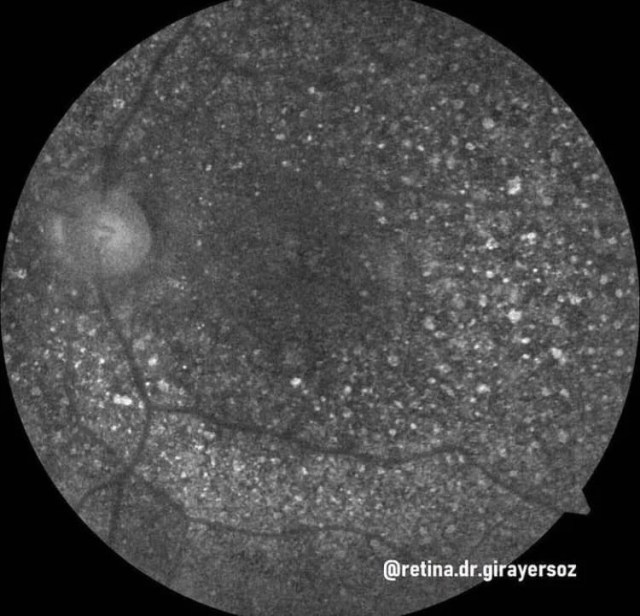What is Bietti’s crystalline dystrophy?
Bietti’s crystalline dystrophy (BCD) is a rare genetic disease. In BCD, crystals made of fatty acids build up in your cornea (the clear outer layer at the front of the eye) and your retina (the light-sensitive layer of tissue in the back of the eye).
Are you an Eye Professional? Register yourself in our Eye professional directory for Free.
Bietti’s Crystalline Dystrophy(BCD):


What are the symptoms of BCD?
The first symptom of BCD is usually a change in your vision. You may notice that you don’t see as clearly as you used to. This includes:
- Blurry or hazy vision
- Trouble seeing in low light
- Not being able to see things out of the corner of your eye (peripheral vision)
- Trouble seeing certain colors
This condition affects both eyes but 1 eye may get worse more quickly than the other.
These early symptoms get worse over time. Eventually, most people with BCD lose most or all of their vision. Many people with BCD can still see things in the center of their vision, but this vision is often blurry.
Notes on Bietti’s Crystalline Dystrophy
![]() The hallmark sign of BCD is white spots or crystals in the retina and corneal stroma.
The hallmark sign of BCD is white spots or crystals in the retina and corneal stroma.
![]() Initially, patients with BCD are often asymptomatic, and the first clinical manifestation most commonly appears between the second and third decade of life.
Initially, patients with BCD are often asymptomatic, and the first clinical manifestation most commonly appears between the second and third decade of life.
![]() As BCD progresses, symptoms appear gradually and painlessly and include night blindness, visual field constriction, color vision impairment, floaters, and photopsias.
As BCD progresses, symptoms appear gradually and painlessly and include night blindness, visual field constriction, color vision impairment, floaters, and photopsias.
![]() At the advanced stage of BCD, patients experience profound visual impairment and become legally blind.
At the advanced stage of BCD, patients experience profound visual impairment and become legally blind.
![]() In 1986, Yugawa et al. classified BCD into the following three stages:
In 1986, Yugawa et al. classified BCD into the following three stages:
![]() Stage 1: RPE atrophy with uniform fine white crystalline deposits is observed in the macular area.
Stage 1: RPE atrophy with uniform fine white crystalline deposits is observed in the macular area.
![]() Stage 2: RPE atrophy extends beyond the posterior pole. Choriocapillaris atrophy, in addition to RPE atrophy, appears markedly at the posterior pole. Crystalline deposits in the lesion vary in shape and size and tend to become confluent. The number of crystalline deposits is lower in the advanced atrophic areas of the RPE-choriocapillaris complex.
Stage 2: RPE atrophy extends beyond the posterior pole. Choriocapillaris atrophy, in addition to RPE atrophy, appears markedly at the posterior pole. Crystalline deposits in the lesion vary in shape and size and tend to become confluent. The number of crystalline deposits is lower in the advanced atrophic areas of the RPE-choriocapillaris complex.
![]() Stage 3: RPE-choriocapillaris complex atrophy is observed throughout the fundus. The total number of crystalline deposits decreases.
Stage 3: RPE-choriocapillaris complex atrophy is observed throughout the fundus. The total number of crystalline deposits decreases.
![]() OCT imaging shows global thinning in the posterior pole and the presence of crystalline deposits.
OCT imaging shows global thinning in the posterior pole and the presence of crystalline deposits.
![]() The crystalline deposits appear as hyperreflective spots. These spots can be observed not only in the RPE and BM but also throughout the neurosensory retina and choroid.
The crystalline deposits appear as hyperreflective spots. These spots can be observed not only in the RPE and BM but also throughout the neurosensory retina and choroid.
![]() OCT also shows the loss of the IS/ OS junction and external limiting membrane, as well as the formation of tubulations in the outer retina.
OCT also shows the loss of the IS/ OS junction and external limiting membrane, as well as the formation of tubulations in the outer retina.
![]() CNV is not common in patients with BCD; however, if present, careful evaluation and management are required.
CNV is not common in patients with BCD; however, if present, careful evaluation and management are required.
![]() FAF can be used to detect the progression of BCD. Hypoautofluorescence is representative of RPE cell loss, and it corresponds to atrophic lesions on OCT.
FAF can be used to detect the progression of BCD. Hypoautofluorescence is representative of RPE cell loss, and it corresponds to atrophic lesions on OCT.
![]() Notably, crystalline deposits in BCD cannot be found in FAF because these deposits are a collection of cholesterolesters.
Notably, crystalline deposits in BCD cannot be found in FAF because these deposits are a collection of cholesterolesters.
![]() In the early stages of BCD, FA shows hyperfluorescent window defects.
In the early stages of BCD, FA shows hyperfluorescent window defects.
![]() Hypofluorescent areas can be seen in the FA in the late stage of the BCD. FA is also useful for the detection of CNVs.
Hypofluorescent areas can be seen in the FA in the late stage of the BCD. FA is also useful for the detection of CNVs.
Credit: Inherited Retinal Disease.
What’s the treatment for BCD?
There is currently no proven treatment for BCD. Living with vision loss or low vision from BCD can be challenging. Having low vision means that even with glasses, contact lenses, medicine, or surgery, your vision loss makes it hard to do everyday tasks.
The good news is, there are things that can help — like low vision devices and rehabilitation (training) programs.
learn more about this disease.


